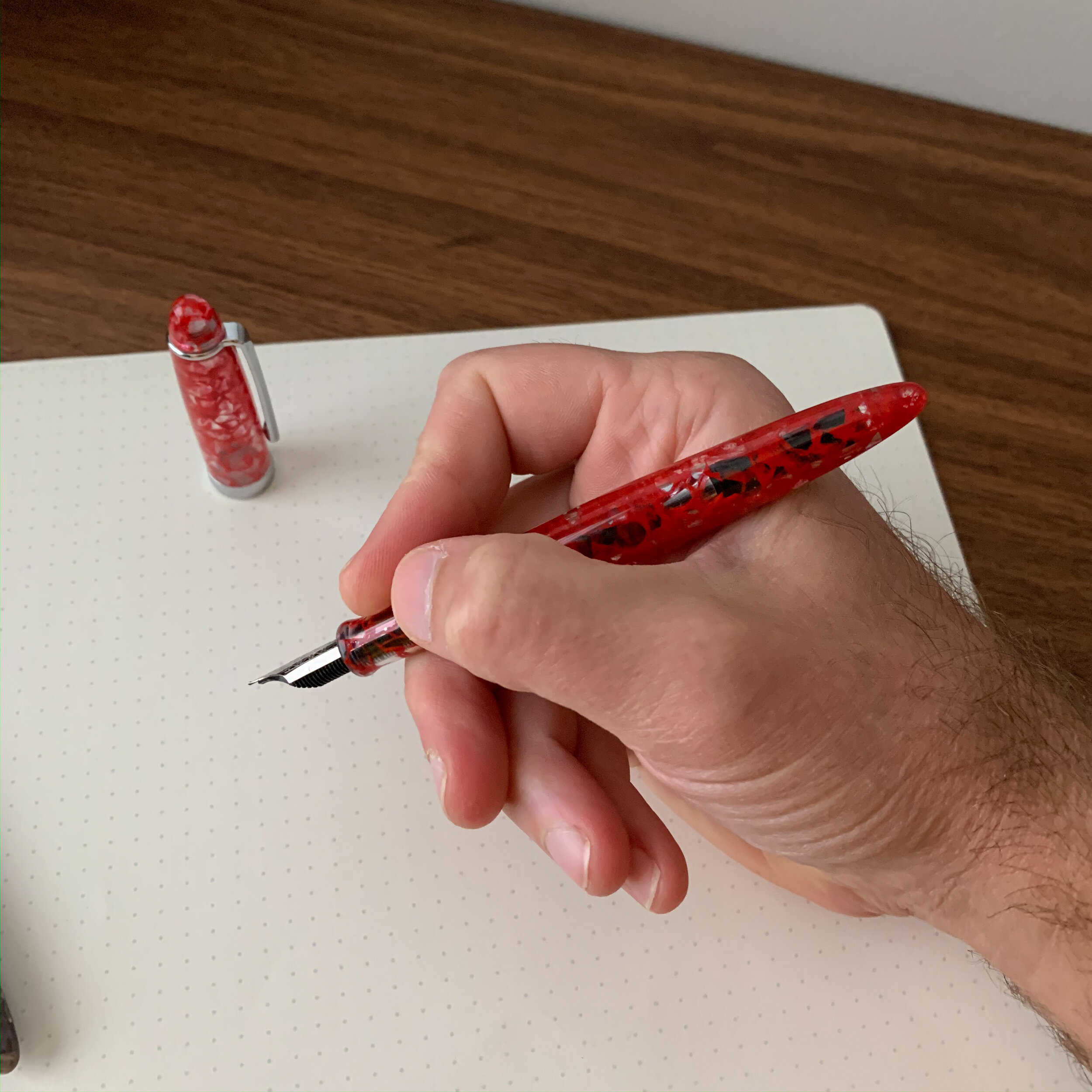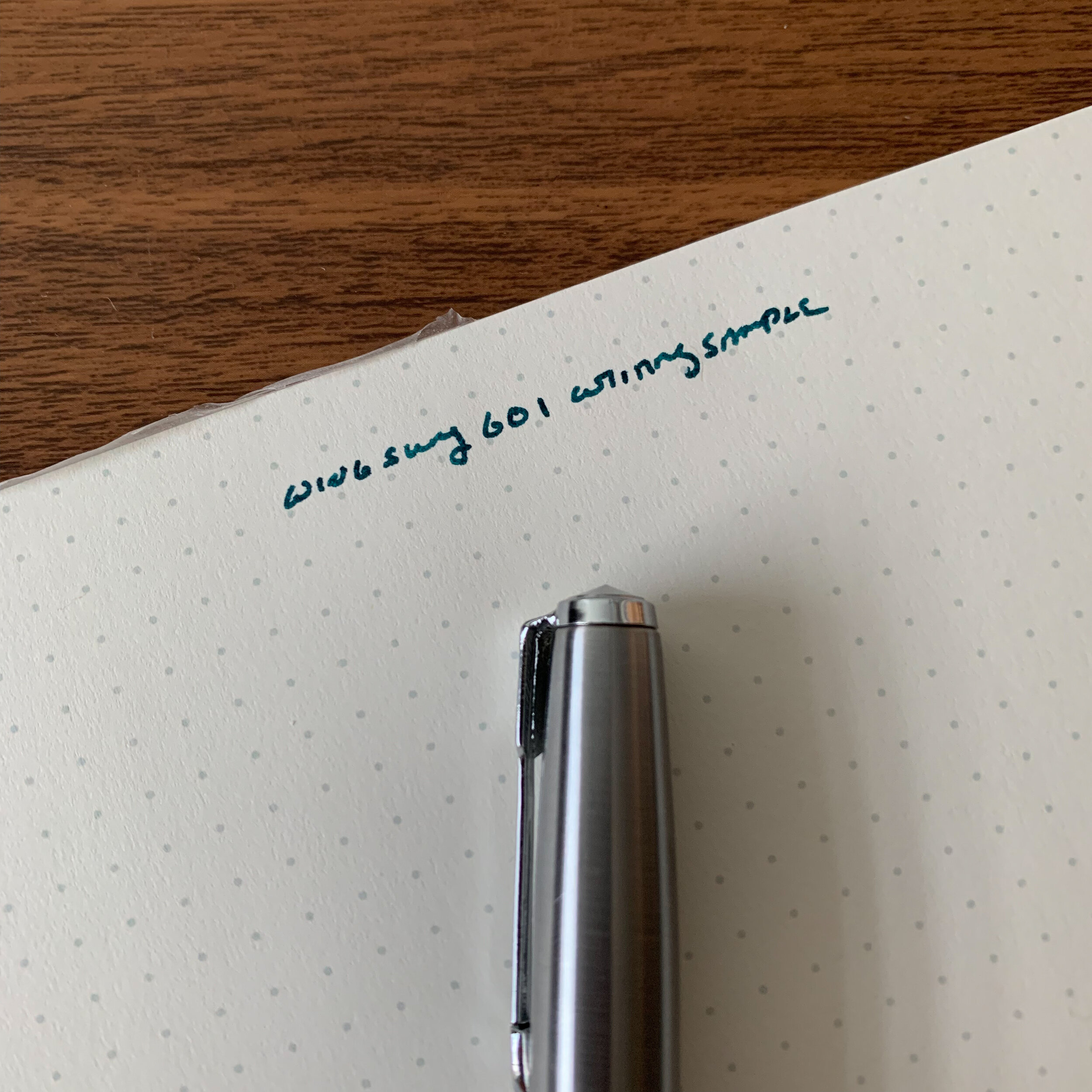Montegrappa has changed its lineup over the years fairly frequently, but the Extra 1930 - which one could comfortably describe as the brand’s “flagship” offering - has remained a constant. The current Extra 1930 is “inspired by a model born over 80 years ago,” and “designed for people who love classic design, original colors and decorations” in line with Montegrappa’s traditional “aesthetic approach.” If you’re a fan of vintage-inspired pen design, like me, then you’ve probably had your eye on one, even if the price point gives you some initial pause.
The Montegrappa Extra 1930 is one of those pens that I always thought would be forever out of my grasp. (Then again, when I first got into fountain pens I also thought a $300 Sailor would remain well out of my comfort zone, but we all know how that story ends up.)
The sterling silver medallion on top of the cap will develop a patina as it ages. You could polish it, and I might eventually, but I like the “antiqued” look.
The Extra 1930 traditionally comes in three different materials, all celluloid: Turtle Brown (shown here); Bamboo Black, and Black & White. Montegrappa also recently added Red and Mediterranean Blue to the lineup, though it’s unclear whether these are temporary or permanent additions. Of the available options, the traditional three are my favorites. Montegrappa accents the celluloid with sterling silver, engraved with what they describe as a “Greek Fret” design on the cap band. A similar pattern adorns the large (No. 8) 18k gold nib, which is paired with an ebonite feed that provides plenty of ink flow. (Note: if you write small, opt for an EF nib, and even then you may have to grind it down. It’s a wet writer.)
That 18k No. 8 nib is gorgeous to look at and a pleasure to write with. It’s not springy, like some larger nibs, and actually quite stiff, but at the same time extremely smooth and an excellent daily writer. The sterling silver section is NOT slippery, and the threads are soft, not sharp. I can write for hours with this pen.
In my opinion, the Montegrappa Extra 1930 offers one of the best high-end writing experiences on the market. What do I mean by that? Sometimes, super-expensive pens are more “art” than “writing instrument.” I don’t purchase pens that I don’t use, so a key point for me in evaluating a specific pen is how comfortable and functional it is to use every day. I go back and forth on whether the Montegrappa Extra 1930 or the Montblanc 146 is my favorite “luxury” fountain pen sold today - they’re both pleasant to write with and superb daily writers. On the Extra 1930, the sterling silver section front-weights the pen and counteracts the weight of the piston, balancing the pen nicely for longer sessions. It’s one of the few pens that I don’t post.
I have no regrets about splurging on the Extra 1930. My own personal “collection” focuses heavily on vintage-inspired modern pens, with a particular emphasis on Italian celluloid. Celluloid pens cannot be acquired inexpensively, since making celluloid is a difficult and time-intensive process, and the material itself has become scarce. Since pen companies OMAS and Delta folded a few years ago, the number of new celluloid pens on the market has dwindled, and even those being released by companies such as Leonardo Officina Italiana and ASC Pens (the “successor” company to OMAS) are using residual celluloid rod stock, which eventually will be gone. Montegrappa appears to be one of the only companies still releasing celluloid pens in proprietary patterns that they developed themselves.
Takeaways and Where to Buy
I love my Extra 1930 - it’s beautiful, and sure it’s expensive, but it’s a writer’s pen with exceptional balance. My one quibble is with the ink capacity. A pen of this size should hold more than .8mm or so of ink, especially one with an ebonite feed. If you opt for a wider nib, you’ll be refilling often.
Despite what I consider to be the generally high quality of their pens, Montegrappa has become known more than anything for their high prices. Unfortunately, the Extra 1930 is no exception, clocking in at a whopping $1,495 MSRP, with the pens actually selling for around $1,100. Is it worth spending this much on a pen? It depends on what you value. In addition to the design, much of the cost here lies in the premium materials used (celluloid, all that sterling silver, and that massive 18kt nib). Looking at comparable pens on the market (ASC Pens Bologna Extra, a Sailor Bespoke King of Pen, Aurora Internazionale), it’s hard to say that Montegrappa’s ask here is out of line with what other companies are charging, but it’s still at or near the top of the market. Because Montegrappa sells a ton of pens at this price point, I don’t expect prices to come down anytime soon.
I purchased my Montegrappa Extra 1930 from Dan Smith at The Nibsmith. One of the great things about purchasing pens from Dan is that, in addition to carrying the full range of Montegrappa pens, he offers nib work on any pens he sells, and on a pen at this price point, any tuning or grind is complimentary. That’s right - you will be paying a LOT for an Extra 1930, but if you purchase from Dan that includes any planned nibwork. Note that Dan is currently running a special on the Black & White Extra 1930, at a price you won’t see very often! .
Disclaimer: I purchased the pen featured in this review with my own funds, at full retail, for my own use. The Nibsmith is a paid sponsor of this blog.









